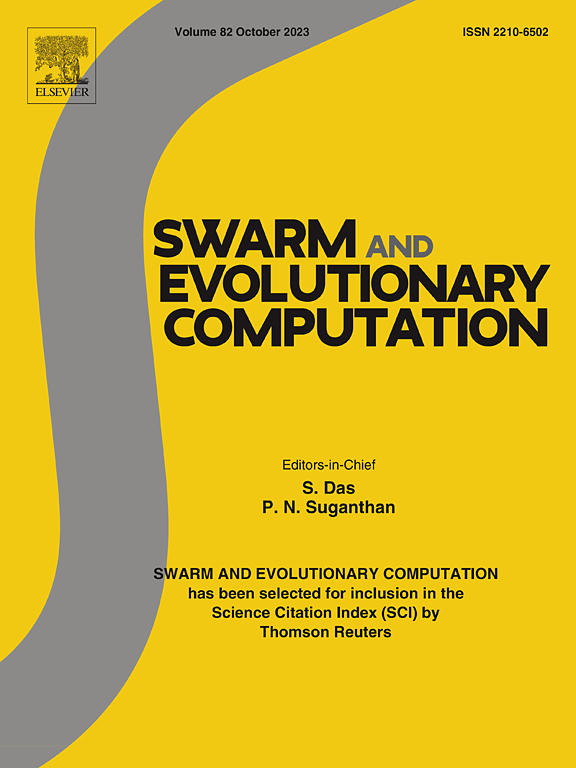Adaptive landscape-aware repelling restart covariance matrix adaptation-evolution strategy for multimodal and global optimization
IF 8.5
1区 计算机科学
Q1 COMPUTER SCIENCE, ARTIFICIAL INTELLIGENCE
引用次数: 0
Abstract
In multimodal optimization using Covariance Matrix Adaptation-Evolution Strategy (CMA-ES), redundant restarts are caused by repeated convergence to previously explored local basins, which leads to significant computational resource waste. To address this problem, previous research proposed the concept of Repelling Restart and developed RR-CMA-ES, but issues remain regarding rigid repulsion and gradient information of local basin structures. Building on this foundation, we propose an Adaptive Landscape-aware Repelling Restart CMA-ES (ALR-CMA-ES) that enhances the original RR-CMA-ES through three key improvements: 1) A fitness sensitive dynamic exclusion mechanism that adaptively adjusts tabu region radius based on local optimality and convergence frequency, prioritizing avoidance of high-quality basins; 2) A covariance matrix mechanism preserving convergence history to geometrically align hyper-ellipsoidal exclusion regions with explored local basin landscapes; 3) A Boltzmann-like probabilistic acceptance scheme incorporating exclusion regions, permit- ting controlled exploration near tabu boundaries. Experiments on the BBOB benchmark demonstrate that ALR-CMA-ES outperforms RR-CMA-ES in 90% of tested problems spanning 2D to 50D. This method provides a practical solution for expensive black-box optimization by systematically integrating landscape topology awareness into tabu mechanisms, while proposing a new solution for multimodal optimization problems.
多模态全局优化的自适应景观感知排斥重启协方差矩阵自适应进化策略
在基于协方差矩阵自适应进化策略(CMA-ES)的多模态优化中,由于对先前探索过的局部流域的重复收敛导致了冗余重启,导致了大量的计算资源浪费。针对这一问题,已有研究提出了斥力重启的概念,并开发了RR-CMA-ES,但对于刚性斥力和局部盆地构造的梯度信息仍然存在问题。在此基础上,提出了一种基于自适应景观感知的击退重启CMA-ES (ALR-CMA-ES)算法,该算法通过三个关键改进改进了原RR-CMA-ES算法:1)基于局部最优性和收敛频率自适应调整禁忌区域半径的适应度敏感动态排除机制,优先避开优质盆地;2)保留收敛历史的协方差矩阵机制将超椭球排斥区与探索的局部盆地景观进行几何对齐;3)包含排除区域的类玻尔兹曼概率接受方案,允许在禁忌边界附近进行可控勘探。在BBOB基准测试上的实验表明,在90%的2D到50D测试问题中,ALR-CMA-ES优于RR-CMA-ES。该方法将景观拓扑感知系统地集成到禁忌机制中,为昂贵的黑盒优化提供了实用的解决方案,同时为多模态优化问题提供了一种新的解决方案。
本文章由计算机程序翻译,如有差异,请以英文原文为准。
求助全文
约1分钟内获得全文
求助全文
来源期刊

Swarm and Evolutionary Computation
COMPUTER SCIENCE, ARTIFICIAL INTELLIGENCEC-COMPUTER SCIENCE, THEORY & METHODS
CiteScore
16.00
自引率
12.00%
发文量
169
期刊介绍:
Swarm and Evolutionary Computation is a pioneering peer-reviewed journal focused on the latest research and advancements in nature-inspired intelligent computation using swarm and evolutionary algorithms. It covers theoretical, experimental, and practical aspects of these paradigms and their hybrids, promoting interdisciplinary research. The journal prioritizes the publication of high-quality, original articles that push the boundaries of evolutionary computation and swarm intelligence. Additionally, it welcomes survey papers on current topics and novel applications. Topics of interest include but are not limited to: Genetic Algorithms, and Genetic Programming, Evolution Strategies, and Evolutionary Programming, Differential Evolution, Artificial Immune Systems, Particle Swarms, Ant Colony, Bacterial Foraging, Artificial Bees, Fireflies Algorithm, Harmony Search, Artificial Life, Digital Organisms, Estimation of Distribution Algorithms, Stochastic Diffusion Search, Quantum Computing, Nano Computing, Membrane Computing, Human-centric Computing, Hybridization of Algorithms, Memetic Computing, Autonomic Computing, Self-organizing systems, Combinatorial, Discrete, Binary, Constrained, Multi-objective, Multi-modal, Dynamic, and Large-scale Optimization.
 求助内容:
求助内容: 应助结果提醒方式:
应助结果提醒方式:


